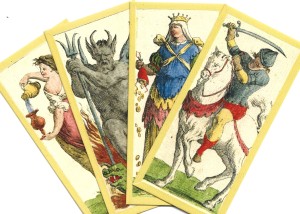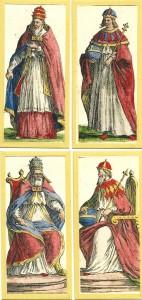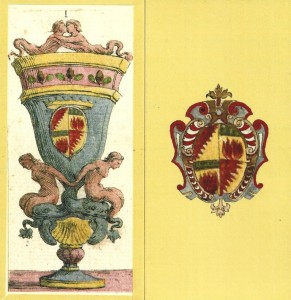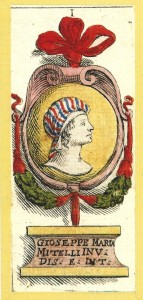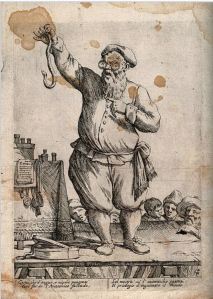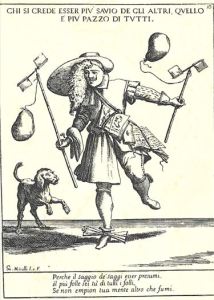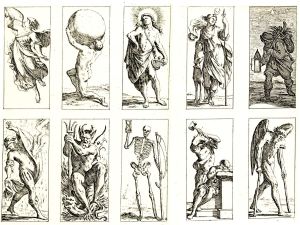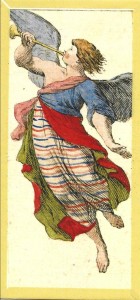I Tarocchi del Mitelli by Marco Benedetti
Today I’m celebrating the artistry of Giuseppe Maria Mitelli along with Marco Benedetti’s luxurious new edition of Mitelli’s tarocchino. I’ll begin by describing Benedetti’s deck; then, I’ll give some background on Mitelli, his artistic output, and the distinct features of his deck. We’ll conclude by looking at other copies of the deck in various museums. But first, what is a tarocchino and what makes this deck so different from other historic tarot decks?
Bologna’s Distinctive Tarocchi
Tarocchino is another name for Tarocco Bolognese, Bologna’s regional variant of the tarot deck. It’s still used today for playing Bologna’s regional version of the game. The traditional 78-card deck is reduced to 62 cards by removing pips two through five from all four suits. Instead of Popess, Empress, Emperor and Pope ranked in order, there are Four Papi who are unnumbered. In 1725, by order of the papal legate, the Papi were replace by four Moors, which is standard on all Bolognese decks up to today. In the few decks that remain from before 1725, the Papi are all seated. Mitelli’s deck has two emperors and two popes, one of each standing, and one of each sitting. The three Virtues are grouped after the Chariot, the Hermit is placed after the Wheel of Fortune, and the Angel/Judgment card is last in the sequence, ranking higher than the World. These changes to the standard 78-card deck were probably made in the sixteenth century, after card games with a shortened deck became popular.
I Tarocchi del Mitelli by Marco Benedetti
The deck produced by Benedetti is a facsimile of a complete deck that was printed from Mitelli’s original copper plates. The deck resides in the British Museum and is housed in a box covered in marbled paper with a red leather label lettered in gold that says, “Mitelli Carte del Taroc“. All the card images in this article are taken from Benedetti’s deck unless stated otherwise.
The backs of the original cards are plain yellow, with no printer’s or merchant’s logo. Rather than being from a commercial print run, it’s possible this particular deck was a special commission for a wealthy connoisseur. Benedetti added the Bentivoglio family arms, which appear on the Ace of Cups, to the card backs. The colors in this example are stronger than in most versions of the deck, another clue that this deck was specially commissioned, then hand painted in saturated colors by a very talented artist.
Benedetti’s deck features hand-folded borders, bordi rivoltinati, the traditional Italian method of card construction that was standard from the 15th to 19th centuries. A thin sheet of paper is glued to the back of each card, the corners clipped, then the edges folded over to the front and glued down. This laborious process creates very sturdy cards that shuffle like a dream and feel like silk.
Benedetti’s deck is housed in a wooden box that is signed and numbered. The cards are the original size, 123 x 59 mm (4.8 x 2.3 inches). For those who prefer a traditional Tarot de Marseille structure, Benedetti has recreated pips two through five of the four suits, and has placed his name, as card maker, on the Four of Coins.
Giuseppe Maria Mitelli
The creator of this deck was born in Bologna in 1634. As the son of a respected artist, he served an extensive apprenticeship under several notable Bolognese masters. Mitelli began his career by creating copper plate etchings of old master oil paintings. He eventually added painter, sculptor, actor, and athlete to his resumé. Copper plate etchings were the mainstay of his career; and over six hundred etchings still exist in museums and private collections. He invented numerous board and card games that he illustrated with scenes from curren/t events and daily life. He also created versions of popular games like Snakes and Ladders and Tarocchi, as well as allegories of the months, and fanciful alphabets, all illustrated with his etchings. Mitelli was especially known for prints satirizing human foibles and moralizing about the vanity of materialism and greed, as well as light-hearted genre scenes of everyday life. Below are two examples.
L’Arte per Via consists of forty illustrations of people plying their trade on the streets: vendors of everything from lace to chicken livers, and porters carrying butchered pigs and barrels of wine. In this print, a quack doctor hawking patent medicines holds up a snake.
Proverbi Figurati illustrates forty-eight popular proverbs. “He who believes he’s wiser than others, is actually crazier than everyone” is illustrated with a bizarrely dressed man holding balloons and whirligigs. Il Meneghello printed facsimiles of these proverb cards in 1985.
Mitelli’s Tarocchi
This Tarocchini was commissioned by Count Bentivoglio sometime between 1660 and 1665. For several centuries, the Bentivoglio were a prominent family in Bologna and Ferra, as well as ruling Bologna in the 15th century. The family’s coat of arms appears on the Ace of Cups, and Mitelli’s self-portrait is on the Ace of Coins.
The original deck was delivered to Count Bentivoglio as six sheets of copper plate engravings, arranged in two rows of 10 to 12 cards to a sheet. It was accompanied by an elaborate dedication page that gives the original name: Giuco di Carte, con nuova forma di Tarocchini.
The deck has all the standard tarot trump cards, but they are rendered with non-traditional images in an elegant, baroque-era style. There is no esoteric symbolism, but there are many references to classical myth such as Cupid (Lovers card) and Apollo (Sun card). The Tower is a lightning-struck man. The rather puzzling Hanged Man card depicts a sleeping man about to have his head bashed in with a very hefty mallet. Are we seeing a murder scene? Some have suggested that this was an actual method of executing criminals.
The cards below show Mitelli at the height of his artistic powers, with the graceful lines of the swords, and the opulent clothing of the court cards. The grotesque faces in the coins hint at Mitelli’s sense of humor.


Other Copies of Mitelli’s Deck
Mitelli’s original copper plates were used for many years after his death to produce commercial print runs of the deck, and for private commissions. The plates were eventually given to the Bentivoglio family, and they disappeared early in the 19th century.
The deck was always printed on six large sheets of paper, just like the original Bentivoglio printing. A workshop cut the etchings into individual cards then colored them by hand. If the deck was a special commission, the owner of the printed sheets would hire a professional artist to color them, then have the etchings cut into individual cards that would be mounted on card stock, or bound into a book to be appreciated as art objects.
The individual cards of a Mitelli deck in the British Museum are bound as pages in a book. The covers are green leather with gold tooling. Since there is no logo on the card backs, this may have been a one-off special commission for a connoisseur who treated the etchings like art objects, not playing cards.
A handful of decks are scattered in European museums, and a few have been reprinted in recent decades. Nearly all existing copies of Mitelli’s deck were produced by the Trombeta workshop. The cards were printed from Mitelli’s original copper plates. The Trombeta name and logo appear on the card backs. It’s not certain how Trombeta obtained the original plates; or if the printing was done by someone else and Trombeta finished the decks and marketed them. It’s possible Mitelli authorized a printer to use his plates during his lifetime.



Above left is a facsimile of a Trombeta deck housed in the Bibliothèque Nationale Française that was produced by Giordano Berti. It displays the delicate watercolor that’s associated with these decks. Il Meneghello reproduced an uncolored deck from a museum collection. The tradition of hiring an artist to color the black and white etchings continues today. The Dal Negro publishing company hired an artist to paint Mitelli’s original etchings with pastel water colors. This deck, above right, is currently available to purchase.
Even though all Mitelli decks were printed from the same plates, none are identical, since the etchings were all hand painted by different artists at different times. But there is one Mitelli deck that is unique.
Barattini’s Wood Block Mitelli
In 1803, nearly 150 years after the original deck was created, another Count Bentivoglio commissioned a wood block version of Mitelli’s deck from the engraver Franciscus Barattini. To comply with the 1725 law, this deck has four Moors instead of the original four Papi. The figures on some cards, like Tower, Sun, and Moon, became mirrored during the copying process. The deck is notable for its strong, vivid colors. Over a century after Mitelli’s death, his deck was still capturing the Bolognese imagination, and was treasured by the Bentivoglio family. The only known copy of this deck is in the British Museum.
These refined, baroque-era cards were designed for Bologna’s upper-class connoisseurs. Benedetti’s deck, with its gorgeous color and hand-folded borders, conveys the luxurious quality of the original.
Contact Marco Benedetti to order a deck: Benedetti.Tarot@gmail.com
Illustrations
I Tarocchi del Mitelli. Facsimile of a deck in British Museum. Marco Benedetti, Rome, 2024.
Marco’s facebook page: https://www.facebook.com/Marco.C.Benedetti.Tarot
I Proverbi Figurati di G. M. Mitelli. Il Meneghello, Milan, 1985
Tarocchi Mitelli Tarot. Facsimile of a deck in the Bibliothèque National Française. Rinascimento Italian Style Art. Giordano Berti, 2017.
https://rinascimentoitalianart.wordpress.com/tarocchi-mitelli-1660/?fbclid=IwAR0-fj8hQL1pYd7uK2crQe05Ipr_kJuc6IJ_KB3AbYBV7K8U2iq6ry34XVk#:~:text=ORIGINI%20DI%20QUESTO%20MAZZO,quali%20erano%20disposte%2062%20carte
Review of Berti’s deck: https://tarot-heritage.com/2017/11/22/the-tarocchino-bolognese-of-giuseppe-mitelli-published-by-giordano-berti/#more-1575
Tarocco Bolognese di G. M. Mitelli. Il Meneghello, Milan, 1992
Tarocchini di G. M. Mitelli. Dal Negro.
https://www.amazon.it/Dal-Negro-42403-Tarocchi-Mitelli/dp/B00642VTKI?ref_=ast_sto_dp
Barattini Woodblock Deck. Franciscus Barattini, 1803, Bologna
https://www.britishmuseum.org/collection/object/P_1896-0501-148?fbclid=IwAR2ITOtCrLXDoiXdlHjVvhktWh9diXzJ4UQg3kbzWcW_G5ulWAjTk_Pg-n4
Not shown:
Unpainted Trombeta Mitelli in the Alava Fournier Museum of Playing Cards, Vitoria, Spain.
https://apps.euskadi.eus/emsime/catalogo/museo-museo-fournier-de-naipes-de-alava/autoria-mitelli-giuseppe-maria-/titulo-tarocchino-de-mitelli/objeto-baraja/ciuVerFicha/museo-2/ninv-43320?fbclid=IwAR3InuueXv-0HIzh8vaCRZ3V7Hkgm5vQv_GnJ0ECkpmiW9R7eq8VR45pHp4

